Full solution
Q. Which recursive sequence would produce the sequence ? and and and and
- Test Option : Let's test the first option: and . We start with . To find , we use the recursive formula: . Now, let's find : . This does not match the given sequence since the third term should be , not .
- Test Option : Let's test the second option: and . We start with . To find , we use the recursive formula: . Now, let's find : . This does not match the given sequence since the third term should be , not .
- Test Option : Let's test the third option: and . We start with . To find , we use the recursive formula: . Now, let's find : . This does not match the given sequence since the third term should be , not .
- Test Option : Let's test the fourth option: and . We start with . To find , we use the recursive formula: . Now, let's find : . This matches the given sequence since the third term is indeed .

